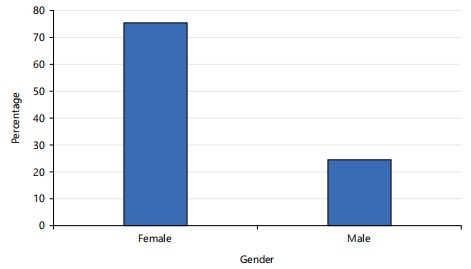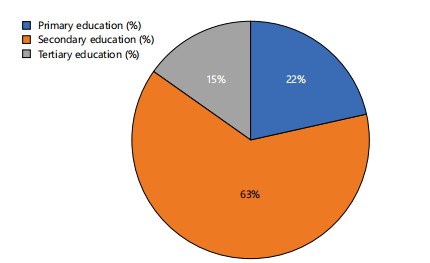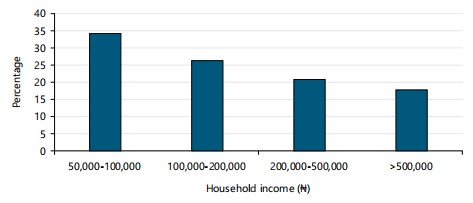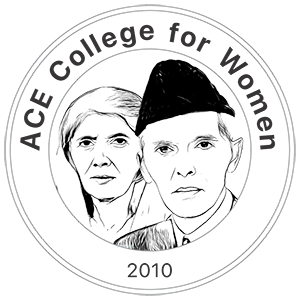Socioeconomic Disparities and Teenage Pregnancy in Bayelsa State, Nigeria: Addressing the Inequality Challenge
| Received 18 May, 2025 |
Accepted 19 Jul, 2025 |
Published 30 Jul, 2025 |
Background and Objective: Teenage pregnancy remains a pressing global concern, with low-income countries reporting up to 15% of women giving birth before age 18 between 2015 and 2020. In Bayelsa State, Nigeria, this issue is exacerbated by pronounced socioeconomic disparities. This study aims to examine the relationship between teenage pregnancy and socioeconomic variables within Bayelsa State, to identify inequality patterns and propose strategies to mitigate them. Materials and Methods: A cross-sectional, quantitative study design was employed, incorporating both primary data collection and literature review. A structured survey was administered to 700 adolescent girls aged 15-19 across the three senatorial districts of Bayelsa State. Descriptive statistics, bivariate, and multivariate analyses were performed using SPSS (versions 18-21) and Microsoft Excel 2000. Key variables included education level, household income, occupation, and parental background. Results: Bivariate analysis revealed significant associations between teenage pregnancy and several socioeconomic factors. Girls with only secondary or primary education had odds ratios of 2.3 and 1.8, respectively. Household income levels of ₦50,000-100,000 and ₦100,000-200,000 were associated with odds ratios of 1.9 and 1.5, respectively. Unemployed adolescents and students had odds ratios of 2.1 and 1.6. Overall, factors such as education, income, parental care, and parental educational attainment showed strong links to increased risk of teenage pregnancy. Conclusion: The findings highlight critical socioeconomic determinants of teenage pregnancy in Bayelsa State. Addressing these disparities requires multi-level governmental and societal interventions. Future studies should explore targeted policy frameworks and longitudinal impacts of socioeconomic reforms on adolescent reproductive health.
INTRODUCTION
Teenage pregnancy is a public health problem with significant social, emotional, and health consequences for both the mother and the child. Its implication leaves them with social stigma and discrimination, including psychological stress, exposing them to a higher risk of health complications during pregnancy and childbirth1. A study has revealed that with babies of older mothers, compared to those born to teenagers are more likely to have lower birth weights, increased infant mortality, and an increased risk of hospital admission in early childhood2. This could be attributed to the global issue of adolescent pregnancy and its attendant effects3.
It has become a growing concern in public health, the issue of teenage pregnancy in Nigeria. The problem keeps escalating and spreading by the day4. That means across the country, probably with the same socioeconomic factors4. Findings indicate that Bayelsa State has one of the highest rates in the country, with far-reaching consequences for adolescents’ health, education, and economic well-being. Socioeconomic inequality is a critical factor contributing to the disparity in teenage pregnancy rates5. Bayelsa State is an oil rich state located in the Niger Delta Region of Nigeria with 8 local government area and a population of about 3 million6-10.
Teenage pregnancy is a complex issue, influenced by a range of socio-economic, cultural, and environmental factors, with severe consequences on the teenager, such as increased risk of maternal and infant mortality, lower educational attainment, and reduced economic opportunities11.
Teenage pregnancy is a significant public health concern globally, with far-reaching consequences on the health, education, and economic well-being of adolescents4,12,13. Bayelsa State was identified as having one of the highest rates of teenage pregnancy in the country, with 22.6% of girls aged 15-19 having begun childbearing14.
Socioeconomic inequalities increase the problems as mentioned above, with disadvantaged groups encountering increased vulnerability15. This study aimed at understanding the socioeconomic disparities in teenage pregnancy in Bayelsa State, with a focus on actors that contribute to these disparities and identifying the inequalities, and the attendant recommendations for the curbing of the conundrum.
This study will contribute to the existing body of knowledge on socioeconomic disparities in teenage pregnancy and strategies for addressing the inequality problem. Furthermore, the findings will aid in policy implications for teenage pregnancy and promote equality among young people in Bayelsa State. It will also provide practical recommendations for addressing socio-economic disparities in teenage pregnancy and promoting equality in Bayelsa State.
MATERIALS AND METHODS
Study location and duration: The study was conducted across the three senatorial districts of Bayelsa State. Ten communities, each in a senatorial district, were the sites where the study took place. Bayelsa State is the cradle of oil exploration and exploitation, created in 1996 under the dictatorial regime of the Late Major. General Sani Abachi with eight local government areas16-20. The study spanned two years from March, 2023 to March, 2025.
Study design/sample size: A quantitative and cross-sectional state-based study design was used for data collection and review of existing literature on socioeconomic disparities in teenage pregnancy and strategies for addressing inequality. A survey of 700 adolescent girls aged 15-19 was conducted in three local senatorial districts of Bayelsa State, Nigeria. The sample size was determined by the method of Althubaiti21, and the design plan was that of Adias et al.22.
Data collection: Data collected was on demographic characteristics: Socioeconomic status, access to education and healthcare, knowledge on reproductive health and behaviors, through a structured questionnaire administered to 700 and an additional 20 adolescent girls who were interviewed more deeply on their experience as teenage mothers to gather more information on their experiences and perspectives. This method was used to ascertain the extent to which teenage pregnancy is concentrated among the disadvantaged groups, while analyzing the disparities in teenage pregnancy in these three local government areas. The questionnaire asked adolescents.
Whilst factors explaining the socio-economic disparities were ascertained, analysis found that several factors contribute to the problem of inequality in teenage pregnancy. These factors include: Education, Poverty, Access to Healthcare, Cultural and Social norms, and Family structure and support.
Data analysis: The choice of statistical tools used was descriptive statistics and bivariate and multivariate analysis on SPSS version 18-21 and Excel 2000 version.
RESULTS
Figure 1 shows the descriptive statistics of the study participants based on gender composition. Out of the 700 young people aged 15-19 in Bayelsa State, females were 75.4%) and males (24.6%). Figure 2 was a presentation of the educational attainments of the participants. Secondary education (63.2%), Primary education (21.5%), Tertiary education (15.3%). Figure 3 shows the household incomes of the participants: ₦50,000-100,000 (34.5%), ₦100,000-200,000 (26.5%), ₦200,000-500,000 (21.1%), >₦500,000 (17.9%). Table 1 shows the attributes of some of the data collected, such as the age, prevalence of teenage pregnancy, age of first pregnancy, and number of pregnancies. Table 2 shows an odds ratio of 2.3 and 1.8 between teenage pregnancy and secondary and primary education on bivariate analysis, respectively. Table 3 shows an odds ratio of 1.9 and 1.5 between teenage pregnancy and household incomes of ₦50,000-100,000 and ₦100,000-200,000, respectively.

|

|

|
| Table 1: | Attributes of some of the data collected | |||
| Attribute | Result |
| Age | 16.5±1.2 years |
| Prevalence of teenage pregnancy | 23.10% |
| Age at first pregnancy | 16.2±1.1 years |
| Number of pregnancies | 1.4±0.6 |
| Table 2: | Relationship between teenage pregnancy and level of education using bivariate analysis | |||
| Comparison | ODD ratio (OR) | CI (95%) |
| Teenage pregnancy and secondary education | 2.3 | 1.4-3.8 |
| Teenage pregnancy and primary education | 1.8 | 1.1-3.1 |
| Table 3: | Relationship between teenage pregnancy and household income using bivariate analysis | |||
| Comparison | ODD ratio (OR) | CI (95%) |
| Teenage pregnancy and ₦50,000-100,000 | 1.9 | 1.2-3.1 |
| Teenage pregnancy and ₦100,000-200,000 | 1.5 | 0.9-2.5 |
| Table 4: | Relationship between teenage pregnancy and employment status using bivariate analysis | |||
| Comparison | ODD ratio (OR) | CI (95%) |
| Teenage pregnancy and unemployment | 2.1 | 1.3-3.4 |
| Teenage pregnancy and student | 1.6 | 0.9-2.8 |
| Table 5: | Relationship between teenage pregnancy (controlling for other variables) and level of education using multivariate analysis | |||
| Comparison | ODD ratio (OR) | CI (95%) |
| Teenage pregnancy and secondary education | 1.9 | 1.1-3.3 |
| Teenage pregnancy and primary education | 1.4 | 0.8-2.5 |
| Table 6: | Relationship between teenage pregnancy (controlling for other variables) and household income using multivariate analysis | |||
| Comparison | ODD ratio (OR) | CI (95%) |
| Teenage pregnancy and ₦50,000-100,000 | 1.6 | 0.9-2.8 |
| Teenage pregnancy and ₦100,000-200,000 | 1.2 | 0.7-2.1 |
| Table 7: | Relationship between teenage pregnancy (controlling for other variables) and lack of or low parental support and guidance using multivariate analysis | |||
| Comparison | ODD ratio (OR) | CI (95%) |
| Teenage pregnancy and lack of parental support and guidance | 1.8 | 75% |
| 25% | ||
| Teenage pregnancy and education of parents: Secondary education | 0.7 | 35% |
| 1.1-1.8 | ||
| Teenage pregnancy and education of parents: Primary education | 1.8 | 75% |
| 0.6-2.0 |
Table 4 shows an odds ratio of 2.1 and 1.6 between teenage pregnancy and unemployment and student hood on bivariate analysis, respectively. Table 5 shows an odds ratio of 1.9 and 1.4 between teenage pregnancy and secondary and primary education on multivariate analysis bivariate analysis, respectively. Table 6 shows an odds ratio of 1.6 and 1.2 between teenage pregnancy and ₦50,000-100,000 and ₦100,000-200,000 on multivariate analysis, respectively. Table 7 shows an odds ratio of 1.8, 0.7, and 1.8 between teenage pregnancy and lack of parental support and guidance, education of parents (secondary education), and education of parents (primary education), on multivariate analysis, respective.
DISCUSSION
The baselines of the study were sampled from questionnaires, interviews, and interactions with emphasis on some thematic areas such as gender (Fig. 1), educational attainments (Fig. 2), and household incomes (Fig. 3). The thematic areas were derived using random selection, which aids in ruling out biased and skewed data interpretation and presentation. Random sampling has also been applied in a handful of empirical studies23-27. Furthermore, to strengthen the basis of the study, certain attributes such as the prevalence of teenage pregnancy, age of first pregnancy, and number of pregnancies were analyzed and used for the validation of the research questions of the study. These considerations align with other empirical studies28-32.
The data analysis revealed that socioeconomic factors such as education (Table 2), household income (Table 3), and occupation (Table 4) were significantly associated with teenage pregnancy in Bayelsa State as specified by the odds numbers using bivariate analysis. The study also found that lack of education and awareness, limited access to healthcare services, cultural and social norms, and poverty and economic instability are some of the underlying factors that contribute to teenage pregnancy. These findings are in line with findings of other researchers in the socio-economic impacts on teenage pregnancies33-35.
Also, the result of this study clearly shows the disparities in socioeconomic status leading to teenage pregnancy in Bayelsa State (Table 5-7). Family structure and support were crucial contributing factors, wherein family dynamics, including parental education and support, also played a crucial role in shaping teenage pregnancy outcomes. Poverty proved to be a very significant reason as household poverty and economic instability increased the possibility of teenage pregnancy in the state, exposing them to seek assistance from the opposite sex, who eventually take advantage of their naivety and lack, and abandon them at the advent of pregnancy. Social attitudes and norms around sexuality, marriage, and childbearing, which influence teenage pregnancy rates, are a result of societal and cultural norm decay. In some culture, marriage is an absolute reserve for adults, and having a child before marriage is a taboo while in other cultures, it makes no difference as some men would want the girl to be pregnant first, to proof her fertility this in turn affects their educational pursuit, lowering their levels of educational attainment. The findings of this study concurred with a handful of other investigators in this field36-39.
Furthermore, 75% of teenagers reported a lack of parental support and guidance, compared to 25% of those who reported having supportive parents (Table 6-7). Those who reported a lack of parental support and guidance were more likely to engage in risky behaviors, including unprotected sex and substance abuse. A majority of these teenagers who reported a lack of parental support and guidance came from low-income families, and parents with limited levels of education. The basis of the relationship between teenage pregnancies and parental care, as advanced by this study, is in line with that of Madkour et al.40, Cooksey41, and Sourth and Baumer42.
The findings of this study have implications for policymakers, stakeholders, and practitioners. The study highlights the need for education and awareness programs that target young people, particularly those from disadvantaged backgrounds. It also emphasizes the importance of improving access to healthcare services, including reproductive health services, for young people. Furthermore, the study suggests that cultural and social norms that perpetuate inequality and limit access to education and healthcare services need to be addressed. Also, the study underscores the need for economic empowerment programs that target young people, particularly those from disadvantaged backgrounds43.
Moreover, this study features the need for a focused intervention to address the socioeconomic disparities in teenage pregnancy in Bayelsa State. Improving access to education and healthcare, especially for adolescent girls from very poor households, is important in reducing the prevalence of teenage pregnancy. Access to education and healthcare were important factors that influence teenagers’ involvement in teenage pregnancy, including adolescent girls who are not privileged to access these services. Consequently, addressing the cultural and social norms that contribute to teenage pregnancy through sensitizations and outreaches was identified as a reasonable means of reducing teenage pregnancy, thereby reducing the prevalence and improving the health and well-being of adolescent girls in Bayelsa State.
The study recommends that policymakers and stakeholders implement programs and policies that address these underlying factors and promote education, healthcare, and economic empowerment for young people inBayelsaState.
CONCLUSION
This study provides valuable insights into the socioeconomic factors that contribute to teenage pregnancy in Bayelsa State. The study highlighted the need for education and awareness programs, improved access to healthcare services, and economic empowerment programs that target young people, particularly those from disadvantaged backgrounds. The study also underscores the importance of addressing cultural and social norms that perpetuate inequality and limit access to education and healthcareservices. This study, therefore, justified the need to understand the socioeconomic disparities in teenage pregnancy in Bayelsa State and identify strategies for addressing equality problems. The study will contribute to the existing body of knowledge on socioeconomic disparities in teenage pregnancy and will help identify policy and practical implications for addressing teenage pregnancy. Based on the findings of this study, future research should consider incorporating the perspectives of key stakeholders such as parents, teachers, and healthcare providers to gain a more comprehensive understanding of the factors influencing teenage pregnancy. Additionally, further studies should evaluate the effectiveness of educational and awareness initiatives, as well as economic empowerment programs, in mitigating the incidence of teenage pregnancy. These areas of focus would contribute valuable insights for designing targeted interventions and informing policy decisions.
SIGNIFICANCE STATEMENT
Teenage pregnancy remains a pressing global concern, with low-income countries reporting up to 15% of women giving birth before age 18 between 2015 and 2020. In Bayelsa State, Nigeria, this issue is exacerbated by pronounced socioeconomic disparities. Bivariate analysis revealed significant associations between teenage pregnancy and several socioeconomic factors. The findings highlight critical socioeconomic determinants of teenage pregnancy in Bayelsa State. Addressing these disparities requires multi-level governmental and societal interventions. Future studies should explore targeted policy frameworks and longitudinal impacts of socioeconomic reforms on adolescent reproductive health.
REFERENCES
- Langille, D.B., 2007. Teenage pregnancy: Trends, contributing factors and the physician's role. Can. Med. Assoc. J., 176: 1601-1602.
- Sutcliffe, A.G., J. Barnes, J. Belsky, J. Gardiner and E. Melhuish, 2012. The health and development of children born to older mothers in the United Kingdom: Observational study using longitudinal cohort data. BMJ, 345.
- Abate, B.B., A.K. Sendekie, A.W. Alamaw, K.M. Tegegne and T.A. Kitaw et al., 2025. Prevalence, determinants, and complications of adolescent pregnancy: An umbrella review of systematic reviews and meta-analyses. AJOG Global Rep., 5.
- Alukagberie, M.E., K. Elmusharaf, N. Ibrahim and S. Poix, 2023. Factors associated with adolescent pregnancy and public health interventions to address in Nigeria: A scoping review. Reprod. Health, 20.
- Elwerfelli, A. and J. Benhin, 2018. Oil a blessing or curse: A comparative assessment of Nigeria, Norway and the United Arab Emirates. Theor. Econ. Lett., 8: 1136-1160.
- Agoro, E.Y.S. and O.N. Agoro, 2025. Ameliorative effect of Phyllanthus amarus (Gale of Wind) on cardiac, renal and hepatic functions of paracetamol intoxicated Wistar rat. Asian J. Biol. Sci., 18: 215-222.
- Agoro, E.Y.S., W.P. Alabrah, G.S. George and M.M. Wankasi, 2024. Homeostatic, glucolytic and lipolytic presentations before and after soccer game. Adv. Res., 25: 99-104.
- Agoro, E.Y.S., E. Osioma and P.W. Alabrah, 2024. The hepato-renal chemistries of rats fed with Pentaclethra macrophylla (oil bean seed). Khalij-Libya J. Dental Med. Res., 8: 229-238.
- Agoro, E.Y.S. and I.V. Anyiam, 2023. The effect of okra (Abelmoschus esculentus) on the hepatic metabolism of carbohydrates and lipids. Asian J. Biol. Sci., 16: 195-201.
- Nikpayam, O., E. Safaei, N. Bahreini and M. Saghafi-Asl, 2021. The effects of okra (Abelmoschus esculentus L.) products on glycemic control and lipid profile: A comprehensive systematic review. J. Funct. Foods, 87.
- Zemene, M.A., B.A. Ayele, E.A. Zewde, T.Y. Yimer, H.S. Hailemeskel and S.A. Tiruneh, 2024. Prevalence and associated factors of teenage pregnancy in Sub-Saharan Africa: Multilevel modified poisson regression analysis. Sage Open, 14.
- Ahinkorah, B.O., M. Kang, L. Perry, F. Brooks and A. Hayen, 2021. Prevalence of first adolescent pregnancy and its associated factors in Sub-Saharan Africa: A multi-country analysis. PLoS ONE, 16.
- Ajala, A.O., 2014. Factors associated with teenage pregnancy and fertility in Nigeria. J. Econ. Sustainable Dev., 5: 62-70.
- Okoli, C.I., M. Hajizadeh, M. Mafizur Rahman, E. Velayutham and R. Khanam, 2022. Socioeconomic inequalities in teenage pregnancy in Nigeria: Evidence from Demographic Health Survey. BMC Public Health, 22.
- Kondo, N., 2012. Socioeconomic disparities and health: Impacts and pathways. J. Epidemiol., 22: 2-6.
- Wankasi, M.M., E.S. Agoro, K.T. Toinpre, E.D. Opugbene, H. Jackto and A.C. Adighije, 2018. Effects of storage duration and temperature on some most frequent routine biochemical parameters. J. Health Med. Nurs., 48: 62-66.
- Wankasi, M.M., E.S. Agoro and P.W. Alabrah, 2018. Comparative study of oral glucose tolerance test levels in pregnant women using glucometer and laboratory glucose oxidase methods. J. Health Med. Nurs., 54: 69-73.
- Wankasi, M.M., E.Y.S. Agoro, P.W. Alabrah and E.O. Tommy, 2019. The effect of tourniquet application on serum calcium and inorganic phosphorus determination. J. Health Med. Nurs., 65: 51-54.
- Martins, W.M., A.E.Y. Solomon and I.C. Germany, 2020. Vitreous humour biochemical parameters as indicators for corroborating acute sniper (Dichlorvos) induced death. J. Forensic Toxicol. Pharmacol., 9.
- Agoro, E.S., G.C. Chinyere, E.I. Akubugwo, M.M. Wankasi and V.N. Agi, 2018. Some vitreous humour cardiorenal biochemical parameters as an indicator of acute carbon monoxide poisoning death: An animal model. Aust. J. Forensic Sci., 51: 476-484.
- Althubaiti, A., 2023. Sample size determination: A practical guide for health researchers. J. Gen. Fam. Med., 24: 72-78.
- Adias, T.C., A.O. Ajugwo, T. Erhabor and C.U. Nyenke, 2013. Effect of pumpkin extract (Telfairia occidentalis) on routine haematological parameters in acetone-induced oxidative stress albino rats. Am. J. Food Sci. Technol., 1: 67-69.
- Ideede, V.T., A.Z. Jeremiah, E.M. Eze, J. Nyebuchi, E.Y.S. Agoro and C. Atiegha, 2021. Assessment of methaemoglobin in haemoglobin variants in selected ethnic groups in Bayelsa State. Int. J. Biochem. Res. Rev., 30: 1-5.
- Zebedee, L.U., Z.A. Jeremiah, N. Jonathan and E.Y.S. Agoro, 2021. Chronic and acute effect of tramadol intoxication on some immunological parameters. Am. J. Immunol., 17: 1-13.
- Agoro, E.S., E. Nelson-Ebimie, A.E. Soroh and J.O. Odegbemi, 2017. The suitability of non-invasive sample in the assay of glucose in diabetes mellitus diagnosis and sex difference. J. Appl. Microbiol. Biochem., 1.
- Agoro, E.Y.S. and T.D. Ibibo, 2021. The consequence of carbon monoxide intoxication on vision biochemistry. Indian Soc. Toxicol., 17: 4-12.
- Almeer, R. and N.M. Alyami, 2023. Renal-protective effect of Asparagus officinalis aqueous extract against lead-induced nephrotoxicity mouse model. Environ. Sci. Pollut. Res., 30: 112745-112757.
- Elleh, B.I., E.S. Bartimaeus, F.U. Igwe, D.G. Tamuno-Emine and E.S. Agoro, 2021. Assessment of some biochemical parameters in vitreous humor of rabbits exposed to sodium cyanide. Ophthalmol. Res. Int. J., 14: 41-47.
- Thompson, I.N., E.S. Bartimaeus, E.O. Nwachuku, H. Brown and E.S. Agoro, 2021. Evaluation of the effect of some marketed herbal cosmetics in Port Harcourt on renal parameters of rabbits. Eur. J. Med. Plants, 32: 70-77.
- Thomas, C.C., A.C. Nsonwu-Anyanwu, C.A.O. Usoro, E.Y.S. Agoro and A.N. Idenyi, 2021. Hepato-renal toxicities associated with heavy metal contamination of water sources among residents of an oil contaminated area in Nigeria. Ecotoxicol. Environ. Saf., 212.
- Ani, M.N. and S.E.Y. Agoro, 2024. Toxicological implications of dichlorvos on thanatomicrobiome profiles and abundance for post mortem investigations. Int. J. Biol. Innovations, 06: 164-179.
- Agoro, E.Y.S. and C.C. Thomas, 2023. Chemistries of monkey tail drink commonly patronized in Otuoke, Bayelsa State, Nigeria. Am. J. Food Technol., 18: 1-7.
- Garwood, S.K., L. Gerassi, M. Jonson-Reid, K. Plax and B. Drake, 2015. More than poverty: The effect of child abuse and neglect on teen pregnancy risk. J. Adolesc. Health, 57: 164-168.
- Zajacova, A. and E.M. Lawrence, 2018. The relationship between education and health: Reducing disparities through a contextual approach. Annu. Rev. Public Health, 39: 273-289.
- Inoue, K., T.E. Seeman, R. Nianogo and Y. Okubo, 2023. The effect of poverty on the relationship between household education levels and obesity in U.S. children and adolescents: An observational study. Lancet Reg. Health Am., 25.
- Stella, A., 2019. Teenage pregnancy and its influence on secondary school education in Nigeria. Br. J. Educ., 7: 87-96.
- Anochie, I.C. and E.E. Ikpeme, 2001. Prevalence of sexual activity and outcome among female econdary school students in Port Harcourt, Nigeria. Afr. J. Reprod. Health, 5: 63-67.
- Ayuba, I.I. and O. Gani, 2012. Outcome of teenage pregnancy in the Niger Delta of Nigeria. Ethiopian J. Health Sci., 22: 45-50.
- Brosh, J., D. Weigel and W. Evans, 2007. Pregnant and parenting adolescents’ perception of sources and supports in relation to educational goals. Child Adolesc. Social Work J., 24: 565-578.
- Madkour, A.S., Y. Xie and E.W. Harville, 2013. The association between prepregnancy parental support and control and adolescent girls' pregnancy resolution decisions. J. Adolesc. Health, 53: 413-419.
- Cooksey, E.C., 1990. Factors in the resolution of adolescent premarital pregnancies. Demography, 27: 207-218.
- Sourth, S.J. and E.P. Baumer, 2001. Community effects on the resolution of adolescent premarital pregnancy. J. Fam. Issues, 22: 1025-1043.
- Alabi, O.T. and I.O. Oni, 2017. Teenage pregnancy in Nigeria: Causes, effect and control. Int. J. Acad. Res. Bus. Social Sci., 7: 17-32.
How to Cite this paper?
APA-7 Style
Diri,
G.E. (2025). Socioeconomic Disparities and Teenage Pregnancy in Bayelsa State, Nigeria: Addressing the Inequality Challenge. Science Digest, 1(1), 61-69. https://doi.org/10.21124/sd.2025.61.69
ACS Style
Diri,
G.E. Socioeconomic Disparities and Teenage Pregnancy in Bayelsa State, Nigeria: Addressing the Inequality Challenge. Science Digest 2025, 1, 61-69. https://doi.org/10.21124/sd.2025.61.69
AMA Style
Diri
GE. Socioeconomic Disparities and Teenage Pregnancy in Bayelsa State, Nigeria: Addressing the Inequality Challenge. Science Digest. 2025; 1(1): 61-69. https://doi.org/10.21124/sd.2025.61.69
Chicago/Turabian Style
Diri, Gloria, Ebibomo.
2025. "Socioeconomic Disparities and Teenage Pregnancy in Bayelsa State, Nigeria: Addressing the Inequality Challenge" Science Digest 1, no. 1: 61-69. https://doi.org/10.21124/sd.2025.61.69

This work is licensed under a Creative Commons Attribution 4.0 International License.



